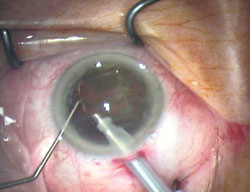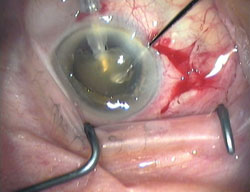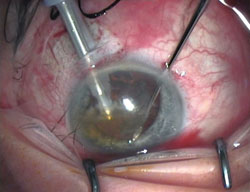Surgeon: ‘Phaco out’ surgery with tools quicker procedure than in-the-bag phaco
Click Here to Manage Email Alerts
Although Charles Kelman, MD, described this type of technique first in 1967, I began “phaco out” cataract surgery in the anterior chamber in 1998 more as a modification of the Maloney technique.
Since then, I have carried out an increasing proportion of my phaco surgery in this manner and it is now virtually 100%.
There are two new instruments that can be used with this technique. First, there is the 90° tip hydrodissector from Aspen Medical, which can be used as a standard hydrodissector and can be placed in any quadrant of the bag, but I prefer it at the 10 o’clock or 2 o’clock position for this technique (Figure 1).

Figure 1. Jacobs hydrodissector being used at 2 o’clock position.

Figure 2. Jacobs anterior chamber chopper.
Images: Jacobs NA
The second instrument is a one-use anterior chamber chopper, which is available from Malosa Medical and has the appearance of a miniature garden hoe (Figure 2). It is suitable for both right- and left-handed surgeons and can be used in two separate ways. I have found the need for this instrument slightly reduced as I now encounter less hard nuclei than previously.
In addition, the newer phacoemulsification machines are superior and thus reduce dependence on the chopper.
Performing technique
For hydrodissection, saline is injected in the usual way, but it is desirable to carry on injecting fluid until one pole of the nucleus pops out of the bag. The 90° hydrodissector tip has the advantage of being able to be used superiorly and thus potentially have more effect on the superior soft lens matter than most hydrodissectors. I feel it is important to evacuate some of the viscoelastic from the anterior chamber before carrying out hydrodissection. It is also important not to use too much force to avoid the risk of blowing out the capsular bag. If the nucleus will not prolapse, this is not a problem because the nucleus can be tumbled easily with the hydrodissector (Figure 3) or, with the second instrument during phacoemulsification.

Figure 3. Nucleus being tumbled into anterior chamber.

Figure 4. Nucleus entirely in anterior chamber.

Figure 5a. Nucleus being reduced from periphery inward.

Figure 5b. Nucleus continues being reduced from periphery inward.
Some more viscoelastic is injected once the nucleus has prolapsed to deepen the anterior chamber.
The nucleus is then fed out of the capsular bag in its entirety and placed in the anterior chamber (Figure 4). With the nucleus in the anterior chamber, it is usually possible to phaco a whole nucleus quickly using a Catherine Wheel method. Starting on the outer edge of the nucleus, the nucleus can be guided into the phaco tip, causing it to rotate and become smaller until a hard remnant can be chopped with a second instrument (Figure 5) if required.
Using anterior chamber chopper
In the case of a harder or larger nucleus, the Malosa anterior chamber chopper can be used as the second instrument. The main technique involves lollypopping the nucleus with the phaco probe (Figure 6) and then, as in the illustration, cutting out a segment of nucleus with the chopper (Figure 7). The chopper is used to hold the body of the nucleus away while the phaco removes the segment (Figure 8).

Figure 6. Fixing the nucleus with the phaco probe.

Figure 7. Chopping out a segment of nucleus.

Figure 8. Removing segment of nucleus.

Figure 9. Chopper inverted to cut remnant in half.
Then the nucleus is rotated slightly and lollypopped again and the procedure is repeated. Alternatively, the anterior chamber chopper can be turned through 180° and placed at the far end of the nucleus and used as a standard chopper to cut the nucleus in half (Figure 9).
About technique
Alió, and colleagues described phaco in the anterior chamber in 2002 and coined the phrase “phaco out” for this type of anterior chamber surgery. Maloney and colleagues brought the nucleus out of the bag and then placed it back through the pupil, but this time on top of the anterior capsule. “Phaco out” involves leaving the nucleus within the anterior chamber in front of the pupil. Dr. Alió showed that comparing this anterior chamber technique with the standard in-the-bag technique, there was no additional loss of endothelial cells.
In my experience, there is a learning curve and some practice is required before this is achieved. Dr.
Alio carries out this technique in selected cases in which there is a suspicion of zonular weakness or, sometimes, in the presence of a small pupil, in which the advantage of anterior chamber surgery is evident. However, I carry this technique out all the time and find that it is quicker and feels much safer and is, therefore, less stressful. Removing the nucleus safely from the bag also has a learning curve. It is not necessary to perform a large capsulorrhexis, as the nucleus will emerge from a normal sized one satisfactorily.
I have not encountered a colleague in the United Kingdom who carries out cataract surgery in this way. I would encourage people who feel experienced at phaco surgery to give this a try and, when carrying out this surgery, always think where the nucleus is relative to the corneal endothelium. It is not so much the nucleus that is the problem but the phaco probe, which should obviously be kept some distance from the corneal endothelium.
I feel this technique is quick and, once mastered, straightforward, reproducible and safer than in-the-bag phacoemulsification. I find my complication rate is definitely reduced with this technique.
References:
- Kelman CD. Phaco-emulsification and aspiration; a new technique of cataract removal; a preliminary report. Am J Ophthalmol. 1967;64: 23-35.
- Maloney WF, Dillman DM, Nichamin LD. Supracapsular phacoemulsification: a capsule-free posterior chamber approach. J Cataract Refract. 1997;23(3): 323-328.
- Alio JL, Mulet ME, Shalaby AMM, Attia WH. Phacoemulsification in the anterior chamber. J Cataract Refract Surg. 2002; 28(1): 67-75.
For more information:
- N.A. Jacobs, FRCS, FRCOphth, is consultant ophthalmic surgeon at Birch Hill Hospital, Rochdale, UK. He can be reached at +144-020-8942-2960; fax: +144-020-8336-0779; email: nick.jacobs@btinternet.com.
- Disclosure: Dr. Jacobs has no relevant financial disclosures.
